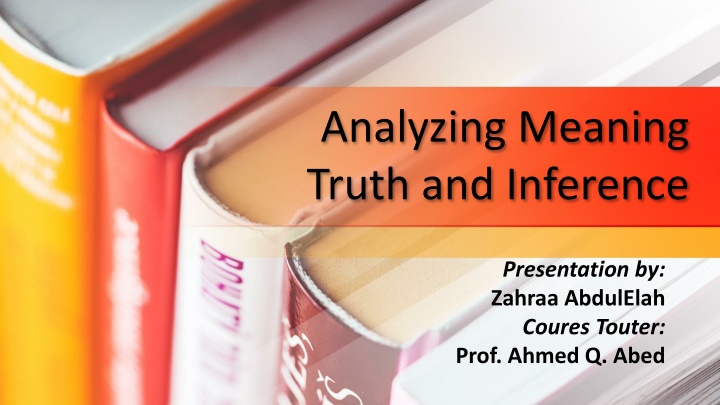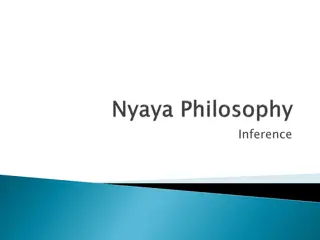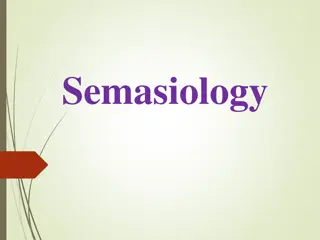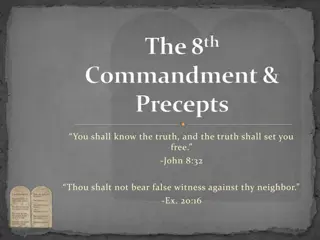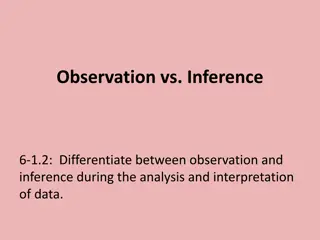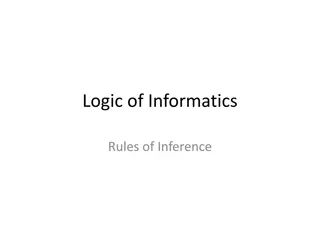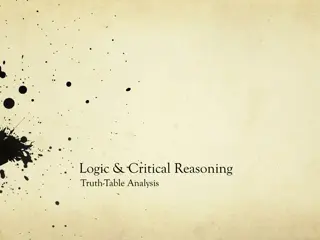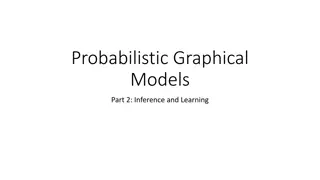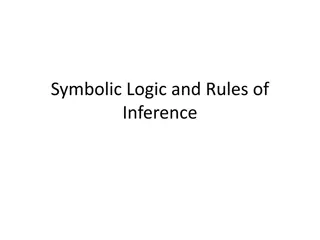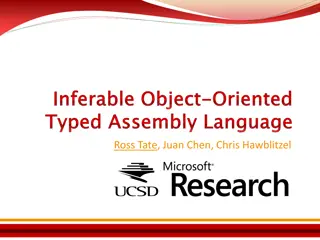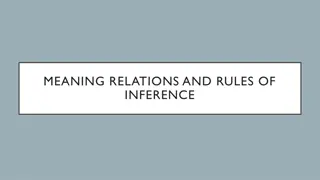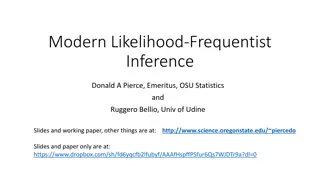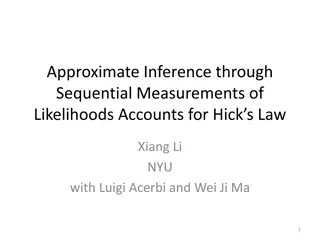Analyzing Meaning, Truth, and Inference
Presentation on truth as a guide to sentence meaning, analytic and synthetic sentences, contradictions, entailment, and meaning relations between propositions. Includes discussions on presupposition and accommodation strategies.
Download Presentation

Please find below an Image/Link to download the presentation.
The content on the website is provided AS IS for your information and personal use only. It may not be sold, licensed, or shared on other websites without obtaining consent from the author.If you encounter any issues during the download, it is possible that the publisher has removed the file from their server.
You are allowed to download the files provided on this website for personal or commercial use, subject to the condition that they are used lawfully. All files are the property of their respective owners.
The content on the website is provided AS IS for your information and personal use only. It may not be sold, licensed, or shared on other websites without obtaining consent from the author.
E N D
Presentation Transcript
Analyzing Meaning Truth and Inference Presentation by: Zahraa AbdulElah Coures Touter: Prof. Ahmed Q. Abed
CONTENTS OF THE PRESENTATION Truth as a guide to sentence meaning. Analytic sentences, synthetic sentences, and contradictions. Meaning relations between propositions. Presupposition. How to identify a presupposition. Accommodation: a repair strategy. Pragmatic vs. semantic aspects of presupposition.
Truth as a guide to sentence meaning Knowing the meaning of a sentence does not necessarily mean that we know whether or not it is true in a particular situation; but it does mean that we know the kinds of situations in which the sentence would be true. e.g. King Henry VIII snores. To know the meaning of a [declarative] sentence is to know what the world would have to be like for the sentence to be true. Dowty et al. (1981: 4). A proposition is a claim about the world which may (in general) be true in some situations and false in others.
Analytic sentences, synthetic sentences, and contradictions Truth condition is determined by the proposition (the sentence meaning). 1) Analytic sentences or Tautologies sentences which are always true, regardless of the circumstances. The utterance's communicative value comes from its pragmatic inference, as it can t come from the truth conditional (if it s always true, it s not giving information) e.g. Today is the first day of the rest of your life. (Attributed to Charles Dederich (1913 1997), founder of the Synanon drug rehabilitation programed religious movement.)
Analytic sentences, synthetic sentences, and contradictions 2) Contradictions opposites of analytic sentences. They are always false in every imaginable situation. e.g. And a woman who held a babe against her bosom said, Speak to us of children. And he said: Your children are not your children. They are the sons and daughters of Life s longing for itself From OnChildren , in The Prophet (Kahlil Gibran, 1923). 3) Synthetic propositions those which are neither contradictions nor analytic. Their truth value derives from world knowledge at that time, or the situation being discussed. Most of the (declarative) sentences that speakers produce in everyday speech are of this type. e.g. Ali s father has just got back from Turkey.
Meaning relations between prepositions Entailment: The relationship between two sentences is from the meaning of those sentences, not the situation or context. e.g. a. Edward VIII has abdicated the throne in order to marry Wallis Simpson. (p) b. Edward VIII is no longer the King. (q) We can say that proposition p entails proposition q just in case the following three things are true: (Cruse (2000: 29). a) Whenever p is true, it is logically necessary that q must also be true; b) Whenever q is false,it is logically necessary that p must also be false; c) these relations follow directly from the meanings of p and q, and do not depend on the context of the utterance.
Meaning relations between prepositions Some ways to test entailment: To be synonymous/paraphrases of each other = two sentences which mutually entail each other. These sentences must both have the same truth conditions in any situation. e.g. a. Hong Kong is warmer than Beijing (in December). b. Beijing is cooler than Hong Kong (in December). Inconsistent/Incompatible= two sentences that can t be true. Propositions with opposite truth values in all circumstances are contradictory. e.g. a. Ringo Starr is my grandfather. b. Ringo Starr is not my grandfather.
Meaning relations between prepositions Contrary = two sentences which can t both be true (it s one or the other), but in a certain context they could both be false. e.g. a. Al is taller than Bill. b. Bill is taller than Al. Independent= sentences aren t compatible. Neither entails the other. No truth value between them, knowing the truth value of one will not provide enough information to know the truth value of the other.
Presupposition Presuppositiondefine as information which is linguistically encoded as being part of the common ground at the time of utterance. common ground refers to everything that both the speaker and hearer know or believe, and know that they have in common. The word or grammatical construction which indicates the presence of a presupposition is called a trigger. e.g. a. Her husband is generous. b. She has a husband.
Presupposition presupposition failure, define as an inappropriate use of a presupposition trigger to signal a presupposition which is not in fact part of the common ground at the time of utterance. e.g. Take some more tea, the March Hare said to Alice, very earnestly. I ve had nothing yet, Alice replied in an offended tone, so I can t take more. (Lewis Carroll, Alice s Adventures in Wonderland)
How to identify a presupposition One of the tests used to check for the presuppositions, involves negating a sentence or change it to interrogative form with a particular presupposition and check if it remains true as in the example below: a) The neighbor s dog killed my cat. b) The neighbor s dog didn t kill my cat. c) Did the neighbor s dog kill my cat?
How to identify a presupposition Von Fintel & Matthewson (2008) describe another test for identifying presuppositions. They point out that if a presupposition is triggered which is not in fact part of the common ground, the hearer can appropriately object by saying something like, Wait a minute, I didn t know that! This kind of challenge is not appropriate for information that is simply asserted, since speakers do not usually assert something which they believe that the hearer already knows, just like the example: a) The mathematician who proved Goldbach s Conjecture is a woman. b) Hey, wait a minute. I had no idea that someone proved Goldbach s Conjecture.
How to identify a presupposition There are five types of triggers to identify presupposition: 1) Definite descriptions Restrictive relative clauses e.g. I m looking for the man who killed my father. (Maddie Ross in the movie True Grit.) definite singular noun phrase e.g. The king of France possessive phrase e.g. My cat
How to identify a presupposition 2) Factive predicates (e.g. regret, aware, realize, know, be sorry that) are predicates that presuppose the truth of their complement clauses. e.g. a. The vice president regrets that he falsified his dental records. b. The vice president doesn t regret that he falsified his dental records. c. Does the vice president regret that he falsified his dental records?Kiparsky & Kiparsky (1970).
How to identify a presupposition 3) Implicative predicates: manage to presupposes try; forget to presupposes intend to; etc. e.g. I manage to catch my bus. 4) Aspectual predicates: (e.g. stop, continue, resume, begin and etc..) e.g. a. Susan has stopped dating that Albanian monk. b. Susan has not stopped dating that Albanian monk. c. Has Susan stopped dating that Albanian monk?
How to identify a presupposition 5) Temporal clauses: Presuppose the truth of their subordinate clauses, while counterfactuals. e.g. Before I moved to Texas, I had never attended a rodeo. Presuppose that their antecedent (if ) clauses are false. e.g. If you had not written that letter, I would not have to fire you. Comparisons like presuppose that the relevant statement holds true for the object of comparison. e.g. Jimmy isn t as unpredictably gauche as Billy.Levinson (1983: 183).
Accommodation: a repair strategy Accommodation: which means presupposition can be introduced as new information. Presupposition must be mutually known or assumed by the speaker and addressee for the utterance to be considered appropriate in context e.g. Are you going to lunch? No, I ve got to pick up my sister. (Stalnaker 1974: 202)
Pragmatic vs. semantic aspects of presupposition Presupposition have treated primarily as a pragmatic issue since it depends heavily on the context of the utterance and the identity of the speech act participants. Presupposition failure, where accommodation is not possible, causes the utterance to be pragmatically inappropriate or infelicitous. Presuppositions can have semantic effects as well. We have said that knowing the meaning (i.e., semantic content) of a sentence allows us to determine its truth value in any given situation.
Pragmatic vs. semantic aspects of presupposition Presupposition failure results in a truth-value gap , or indeterminacy, as defined in purely semantic, truth-conditional terms: One sentence presupposes another just in case the latter must be true in order that the former have a truth value at all. Stalnaker (1973: 447) e.g. a. The present King of France is bald. (p) b. The present King of France is not bald. (q) pq ?(T or F) F
